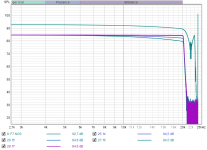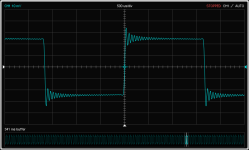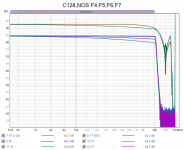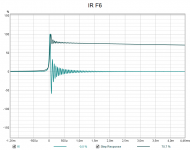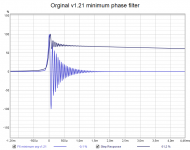I still don't know how to switch between several IIR filters, so I created two different firmware. It looks like it was not intended for this kind of application.
I made two firmware, one with pure impulse response and only anti-aliasing function. The secound is warmed to make it sound more natural.
They all have 3 NOS with different gain. Any feedback is welcome
I made two firmware, one with pure impulse response and only anti-aliasing function. The secound is warmed to make it sound more natural.
They all have 3 NOS with different gain. Any feedback is welcome
Attachments
I have two three beginner questions:
1. When I load a filter on the dam 1021,
do I have to select or activate this via the terminal or in some other way?
2. Is the filter still active after switching off?
3. How do I get the original condition back?
Reload the firmware?
The instructions I read could not answer my questions
1. When I load a filter on the dam 1021,
do I have to select or activate this via the terminal or in some other way?
2. Is the filter still active after switching off?
3. How do I get the original condition back?
Reload the firmware?
The instructions I read could not answer my questions
I run my Soekris via a Raspberry 3B via i2S:
Today I installed the filter package "DIYA_1021filt_DC_v2.skr".
Unfortunately I have the following "peculiarity":
F4 only plays music with:
16 bit / 44.1 kHz is -> 24 bit / 96 kHz remains silent
F5 only reproduces the 24 bit / 96 kHz -> 16 bit /44.1 kHz remains silent.
So I first went back to the original state.
This means that no adjustment is necessary
Today I installed the filter package "DIYA_1021filt_DC_v2.skr".
Unfortunately I have the following "peculiarity":
F4 only plays music with:
16 bit / 44.1 kHz is -> 24 bit / 96 kHz remains silent
F5 only reproduces the 24 bit / 96 kHz -> 16 bit /44.1 kHz remains silent.
So I first went back to the original state.
This means that no adjustment is necessary
I believe the latest version filter I posted is:
Filter brewing for the Soekris R2R
Post #1803
Try that and see if it works better!
//
Filter brewing for the Soekris R2R
Post #1803
Try that and see if it works better!
//
Minimum phase response firmware.
Full attenuation at 22k50Hz IIR anti-aliasing cascaded filters
Magnitude response slop -0.7dB to -5.1dB at 20kHz depending from chosen filter (compared to NOS from DIYA noDC filter pack)
All FIR filters build around “NOS philosophy” and CD quality audio.
F7 filter – NOS should work with higher frequency(not tested)
Gain leveled between filters but still much lower than original firmware.
DC filter changed.
Full attenuation at 22k50Hz IIR anti-aliasing cascaded filters
Magnitude response slop -0.7dB to -5.1dB at 20kHz depending from chosen filter (compared to NOS from DIYA noDC filter pack)
All FIR filters build around “NOS philosophy” and CD quality audio.
F7 filter – NOS should work with higher frequency(not tested)
Gain leveled between filters but still much lower than original firmware.
DC filter changed.
Attachments
I still don't know how to switch between several IIR filters, so I created two different firmware. It looks like it was not intended for this kind of application.
I made two firmware, one with pure impulse response and only anti-aliasing function. The secound is warmed to make it sound more natural.
They all have 3 NOS with different gain. Any feedback is welcome
Hi!
How did you implement "external IIR filter"? Just curious.
There is no way of switching IIR filters. There can be only one set per Fs hierarchy i.e. 2 - one for the 44,1 based Fs and one for 48 ones. If you generate these 2 sets for the correct FIR1 frequencies they will be correctly activated depending on incoming Fs.
If you want to try different IIR filters for say 44,1, you need as you have done, load different set of filters (you don't need to reload FW, only filter file)
If you want to follow the sampling theorem you would like full attenuation at 22,05, not 22,5.
//
Hi!
How did you implement "external IIR filter"? Just curious.
There is no way of switching IIR filters. There can be only one set per Fs hierarchy i.e. 2 - one for the 44,1 based Fs and one for 48 ones. If you generate these 2 sets for the correct FIR1 frequencies they will be correctly activated depending on incoming Fs.
If you want to try different IIR filters for say 44,1, you need as you have done, load different set of filters (you don't need to reload FW, only filter file)
If you want to follow the sampling theorem you would like full attenuation at 22,05, not 22,5.
//
For external IIR Filtering I was using Equalizer APO application. IIR can be implemented by algorithm or coefficients.
Last filters set It is fully attenuated with 15th order IIR according to sampling theorem 22k50Hz (k states for thousand) and it’s noted in Hz not kHz
Are those 2K or 4K filters ?
In fact none of them 😊
FIR filters are only used on upsampling process with as small as possible influence to signal and no antialiasing purpose at all.
FIR filters have only 8 coefficients. 4 different types, one classic nos.
Antialiasing is done completely by 15th order IIR filter – so it can be treated as analog way of filtering.
To compensate effects of that type of antialiasing filtering there is 8th order allpass IIR filter.
Are those 2K or 4K filters ?
IIR filters has no bearing on 2k/4k taps.
//
Are those 2K or 4K filters ?
Very interesting! How does this compare to Paul's NewNOS and C128dp filters?
You have to try and tell me 😊
Paul’s NewNOS and C128dp they were inspiration. I trying to preserve all good things they have, tonal balance, dynamic, engagement and remove aliasing completely.
There is still a lot to improve especially with upsampling FIR filters and all pass filter. That’s why there are 4 filters to test and explore and share comments.
This kind of filtering it’s bit different from standard FIR Minimum phase filter.
Attachments
I will definitely give them a first spin tonight.
From the TXT file I see they are like NewNOS, i.e. only eight coefficients and evenly distributed. My experience with NewNOS was an audible grain in the midrange -- way too much so. Not analog sounding, but raspy. So I was thinking if you could combine the C128dp coefficients with your IIR filters.
As I only listen at 16 bit 44,1 kHz, and you say your filters are optimized for such CD quality, that might just be gold.
Edit: also who needs DC filters anyway?
From the TXT file I see they are like NewNOS, i.e. only eight coefficients and evenly distributed. My experience with NewNOS was an audible grain in the midrange -- way too much so. Not analog sounding, but raspy. So I was thinking if you could combine the C128dp coefficients with your IIR filters.
As I only listen at 16 bit 44,1 kHz, and you say your filters are optimized for such CD quality, that might just be gold.
Edit: also who needs DC filters anyway?
Last edited:
So, filters with txt file it’s my generic try to marry NOS with IIR. You should leave it and try the last one.
NewNOS is formally moving average filter which is not perfect one and can be fatiguing.
At the beginning I was thinking that cause of that is aliasing but I was wrong.
That’s why I’m searching for different solution combination to do smooth upsampling. F4-F6.
F7 filter is NOS/NewNOS combination – which should be better.
Filters structure allow only for one set of cascaded IIRs filters so everything one will throw in will be filtered to 20kHz audio output.
And my setup is fixed with CD quality.
DC filter has influence on how fast frequency roll-off and step response, in fact in future it can be changed or removed but it’s more final adjustment. I changed because original was too aggressive.
Waiting for You comment.
NewNOS is formally moving average filter which is not perfect one and can be fatiguing.
At the beginning I was thinking that cause of that is aliasing but I was wrong.
That’s why I’m searching for different solution combination to do smooth upsampling. F4-F6.
F7 filter is NOS/NewNOS combination – which should be better.
Filters structure allow only for one set of cascaded IIRs filters so everything one will throw in will be filtered to 20kHz audio output.
And my setup is fixed with CD quality.
DC filter has influence on how fast frequency roll-off and step response, in fact in future it can be changed or removed but it’s more final adjustment. I changed because original was too aggressive.
Waiting for You comment.
Wow this is really hard  I don't have that golden ear -- yes I am a critical listener but doubt that I would be consistent in a blind listening test. Reporting anything here I risk looking like an audiophool, but hey, I'll take a stab at it anyway.
I don't have that golden ear -- yes I am a critical listener but doubt that I would be consistent in a blind listening test. Reporting anything here I risk looking like an audiophool, but hey, I'll take a stab at it anyway.
Off the bat, the filters all sound good to me. F4-F6, I'm not sure if even hear a difference. They all are revealing, dynamic, percussion sounds natural and distorted guitars "rock".
If could pick up anything, it's two things. First that I think that F5 is slightly more forward than F4, which I like. Second, which I can only pick up in classical music / piano passages, the F7 seems to have better attack and air than F5, and again I prefer the former.
So, after one session of listening, how did I do?
Off the bat, the filters all sound good to me. F4-F6, I'm not sure if even hear a difference. They all are revealing, dynamic, percussion sounds natural and distorted guitars "rock".
If could pick up anything, it's two things. First that I think that F5 is slightly more forward than F4, which I like. Second, which I can only pick up in classical music / piano passages, the F7 seems to have better attack and air than F5, and again I prefer the former.
So, after one session of listening, how did I do?
At the end of the evening I set filter = soft / F7.
As for the comparison to C128dp, I asked myself the same thing. I find it very difficult to comment because there's no easy switching between the two. So anything near A/B-testing is nigh impossible. They both approach that "vinyl" sound I'm looking for.
I know there are people here with better trained ears than mine, looking forward to their comments.
As for the comparison to C128dp, I asked myself the same thing. I find it very difficult to comment because there's no easy switching between the two. So anything near A/B-testing is nigh impossible. They both approach that "vinyl" sound I'm looking for.
I know there are people here with better trained ears than mine, looking forward to their comments.
- Home
- Source & Line
- Digital Line Level
- Filter brewing for the Soekris R2R
